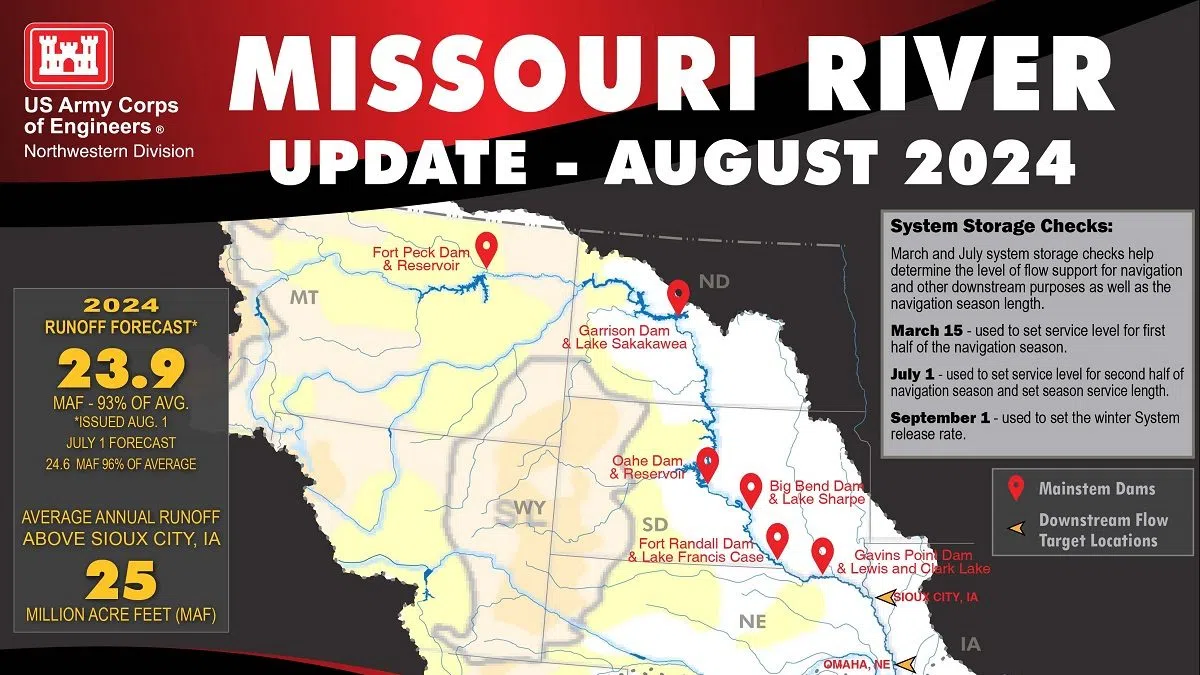July runoff in the Missouri River basin above Sioux City, Iowa was 2.8 million acre-feet, 85% of average with below-average runoff in the upper three reaches and above-average runoff in the lower three reaches. The annual runoff forecast above Sioux City, Iowa is 23.9 MAF, 93% of average.
“July brought warmer and drier weather to the Missouri River Basin,” said John Remus, chief of the U.S. Army Corps of Engineers’ Missouri River Basin Water Management Division. “While every state experienced storms that produced small pockets of above average rainfall, overall precipitation was below normal for the basin.”
The drought monitor for July 30 shows 59% of the Basin in abnormally dry (D0) or worse category. Soils are drier than normal in the western portion of the basin and wetter than normal in the eastern portion of the basin. The drought outlook extending through the end of October shows drought conditions persisting or worsening for the western half of the basin.
System storage peaked on July 11 at 57.0 MAF. System storage on Aug. 1 was 56.5 MAF, 0.4 MAF above the base of the Annual Flood Control and Multiple Use zone.
“Reservoir inflows in July declined due to warmer and drier conditions in the upper Missouri River basin. After peaking in mid-July, System storage is expected to continue declining into the Carryover Multiple Use Zone during the remainder of 2024 as we make releases during the summer and fall periods to support the authorized purposes,” said Remus.
“The monthly study indicates that the winter release from Gavins Point, which is based on the Sept. 1 System storage check, will likely be near the minimum rate of 12,000 cfs,” added Remus.
Basin and river conditions continue to be monitored and System regulation will be adjusted based on the most up-to-date information.
The six mainstem power plants generated 631 million kWh of electricity in July. Typical energy generation for July is 954 million kWh. The power plants are expected to generate 8.0 billion kWh this year, compared to the long-term average of 9.4 billion kWh.
Reservoir Forecasts:
- Big Bend Dam
- Average releases past month – 12,100 cfs
- Forecast average release rate – 27,000 cfs
- Forecast end-of-August reservoir level – 1420.6 feet
- Oahe Dam
- Average releases past month – 11,900 cfs
- Forecast average release rate – 27,400 cfs
- End-of-July reservoir level – 1605.6 feet (up 2.6 feet from June 30)
- Forecast end-of-August reservoir level – 1604.2 feet
The forecast reservoir releases and elevations discussed above are not definitive. Additional precipitation, lack of precipitation or other circumstances could cause adjustments to the reservoir release rates.
Fort Peck Flow Test:
Test releases from Fort Peck to assess the potential benefits of alternative management scenarios for the pallid sturgeon began on April 26 and were terminated early due to lack of evidence of spawning. The test included two higher flow periods, in late April and June, with target flows at Wolf Point, Montana. The first peak in releases was completed in early May with peak flows of 18,000 cfs at Wolf Point, Montana. Releases were reduced to 10,000 cfs by May 10. The second peak began on June 19 and reached a peak flow of approximately 20,000 cfs on June 26. Flows were then decreased to an average daily flow of 8,000 cfs around July 7. Releases were increased to 9,000 cfs on July 25 after Fort Peck resumed normal operations. A female pallid sturgeon was recaptured on July 31, and it was determined via ultrasound that it had spawned. The spawning is the second ever confirmed spawning event on the Missouri River between Fort Peck and Garrison Dams. The United States Geological Survey is reviewing telemetry data to narrow down the location and timing of the spawning.
To view the detailed three-week release forecast for the mainstem dams, go to https://go.usa.gov/xARQB.
The Missouri Basin Web App provides links to these reports and others that are updated more frequently. http://go.usa.gov/xE6fC.

